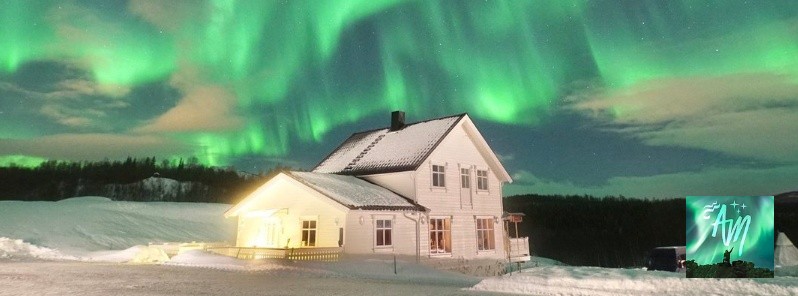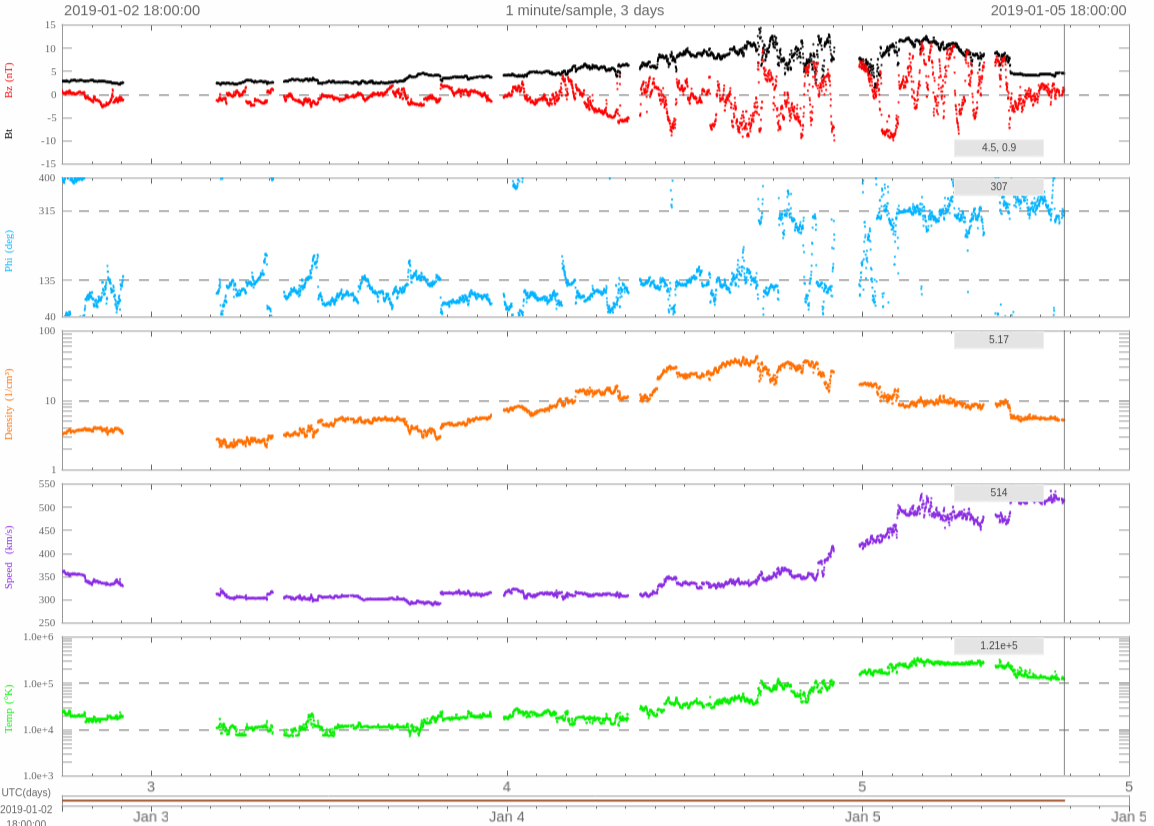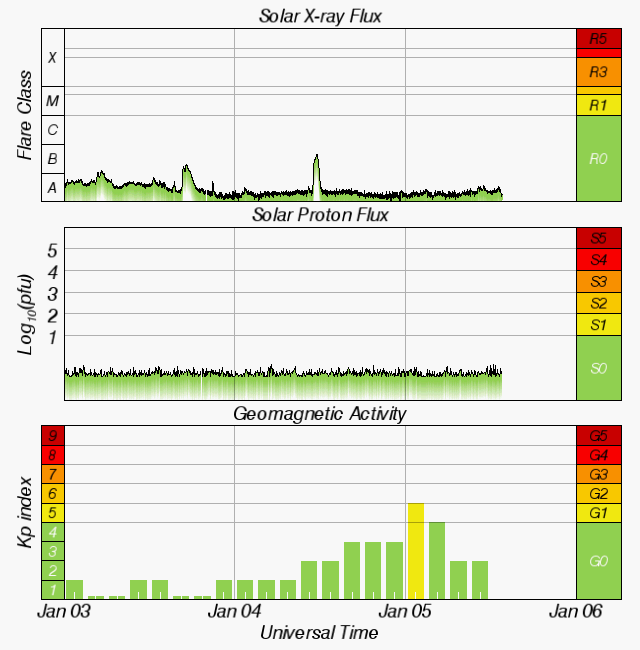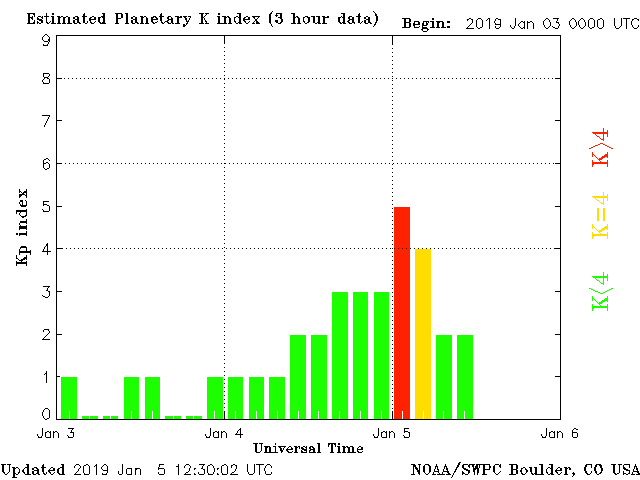Negative polarity CH HSS sparks G1 – Minor geomagnetic storming

A large negative polarity coronal hole is affecting our planet, causing G1 – Minor geomagnetic storming. Geomagnetic K-index of 5 (G1 – Minor geomagnetic storm) threshold was reached at 01:37 UTC, January 5, 2019.
Solar wind parameters, as measured by the DSCOVR spacecraft, indicated the onset of influence from a negative polarity CH HSS over the past 24 hours. Total magnetic field strength reached a brief peak of 14 nT around 17:00 UTC on January 4. The Bz component reached as far south as -10 nT around 02:00 UTC, January 5. Solar wind speeds increased from near 350 km/s at 21:00 UTC, January 4 to peak of 558 km/s observed at 10:12 UTC, January 5. Phi angle shifted from predominantly positive to negative after 01:00 UTC, January 5.
Solar wind parameters are expected to continue at enhanced levels due to CH HSS influence through January 6. Mostly background conditions are expected by the end of January 7.

G1 -Minor geomagnetic storm conditions are likely on January 5 due to the continued influence of a negative polarity CH HSS. Unsettled to active levels are likely on January 6 and quiet to unsettled levels are likely on January 7 as influence from the CH HSS slowly diminishes.
The greater than 2 MeV electron flux was at moderate to background levels and the greater than 10 MeV proton flux was steady at background levels over the past 24 hours. The greater than 2 MeV electron flux is expected to be at normal to moderate levels January 5, and moderate to high levels January 6 and 7 in response to a CH HSS. The greater than 10 MeV proton flux is expected to persist at background levels through January 7.


Solar activity remained very low over the past 24 hours. Region 2732 (N09W68, Bxo/beta), the only numbered region, exhibited decay among all the spots.

Sunspots on January 5, 2019. Credit: NASA SDO/HMI
A Coronal Mass Ejection (CME) was observed in LASCO C2 coronagraph imagery at 23:24 UTC on January 2, likely from a filament eruption that occurred near (S71W49). However, analysis of STEREO and LASCO coronagraph imagery determined it to have a trajectory south and west of Earth. No impacts are expected from this event.
SWPC Alerts, Watches and Warnings
Space Weather Message Code: WARK04
Serial Number: 3578
Issue Time: 2019 Jan 05 1155 UTC
EXTENDED WARNING: Geomagnetic K-index of 4 expected
Extension to Serial Number: 3577
Valid From: 2019 Jan 04 2327 UTC
Now Valid Until: 2019 Jan 05 2359 UTC
Warning Condition: Persistence
NOAA Space Weather Scale descriptions can be found at
www.swpc.noaa.gov/noaa-scales-explanation
Potential Impacts: Area of impact primarily poleward of 65 degrees Geomagnetic Latitude.
Induced Currents – Weak power grid fluctuations can occur.
Aurora – Aurora may be visible at high latitudes such as Canada and Alaska.
***
Space Weather Message Code: ALTK05
Serial Number: 1255
Issue Time: 2019 Jan 05 0137 UTC
ALERT: Geomagnetic K-index of 5
Threshold Reached: 2019 Jan 05 0137 UTC
Synoptic Period: 0000-0300 UTC
Active Warning: Yes
NOAA Scale: G1 – Minor
NOAA Space Weather Scale descriptions can be found at
www.swpc.noaa.gov/noaa-scales-explanation
Potential Impacts: Area of impact primarily poleward of 60 degrees Geomagnetic Latitude.
Induced Currents – Weak power grid fluctuations can occur.
Spacecraft – Minor impact on satellite operations possible.
Aurora – Aurora may be visible at high latitudes, i.e., northern tier of the U.S. such as northern Michigan and Maine.
***
Space Weather Message Code: WARK05
Serial Number: 1507
Issue Time: 2019 Jan 05 0113 UTC
WARNING: Geomagnetic K-index of 5 expected
Valid From: 2019 Jan 05 0113 UTC
Valid To: 2019 Jan 05 0900 UTC
Warning Condition: Onset
NOAA Scale: G1 – Minor
NOAA Space Weather Scale descriptions can be found at
www.swpc.noaa.gov/noaa-scales-explanation
Potential Impacts: Area of impact primarily poleward of 60 degrees Geomagnetic Latitude.
Induced Currents – Weak power grid fluctuations can occur.
Spacecraft – Minor impact on satellite operations possible.
Aurora – Aurora may be visible at high latitudes, i.e., northern tier of the U.S. such as northern Michigan and Maine.
***
Space Weather Message Code: ALTK04
Serial Number: 2093
Issue Time: 2019 Jan 05 0055 UTC
ALERT: Geomagnetic K-index of 4
Threshold Reached: 2019 Jan 05 0055 UTC
Synoptic Period: 0000-0300 UTC
Active Warning: Yes
NOAA Space Weather Scale descriptions can be found at
www.swpc.noaa.gov/noaa-scales-explanation
Potential Impacts: Area of impact primarily poleward of 65 degrees Geomagnetic Latitude.
Induced Currents – Weak power grid fluctuations can occur.
Aurora – Aurora may be visible at high latitudes such as Canada and Alaska.
***
Space Weather Message Code: WARK04
Serial Number: 3577
Issue Time: 2019 Jan 04 2327 UTC
WARNING: Geomagnetic K-index of 4 expected
Valid From: 2019 Jan 04 2327 UTC
Valid To: 2019 Jan 05 1200 UTC
Warning Condition: Onset
NOAA Space Weather Scale descriptions can be found at
www.swpc.noaa.gov/noaa-scales-explanation
Potential Impacts: Area of impact primarily poleward of 65 degrees Geomagnetic Latitude.
Induced Currents – Weak power grid fluctuations can occur.
Aurora – Aurora may be visible at high latitudes such as Canada and Alaska.
***
Space Weather Message Code: WATA20
Serial Number: 848
Issue Time: 2019 Jan 02 2221 UTC
WATCH: Geomagnetic Storm Category G1 Predicted
Highest Storm Level Predicted by Day:
Jan 03: None (Below G1) Jan 04: None (Below G1) Jan 05: G1 (Minor)
THIS SUPERSEDES ANY/ALL PRIOR WATCHES IN EFFECT
NOAA Space Weather Scale descriptions can be found at
www.swpc.noaa.gov/noaa-scales-explanation
Potential Impacts: Area of impact primarily poleward of 60 degrees Geomagnetic Latitude.
Induced Currents – Weak power grid fluctuations can occur.
Spacecraft – Minor impact on satellite operations possible.
Aurora – Aurora may be visible at high latitudes, i.e., northern tier of the U.S. such as northern Michigan and Maine.
Featured image copyright: Adrien Mauduit

Commenting rules and guidelines
We value the thoughts and opinions of our readers and welcome healthy discussions on our website. In order to maintain a respectful and positive community, we ask that all commenters follow these rules.